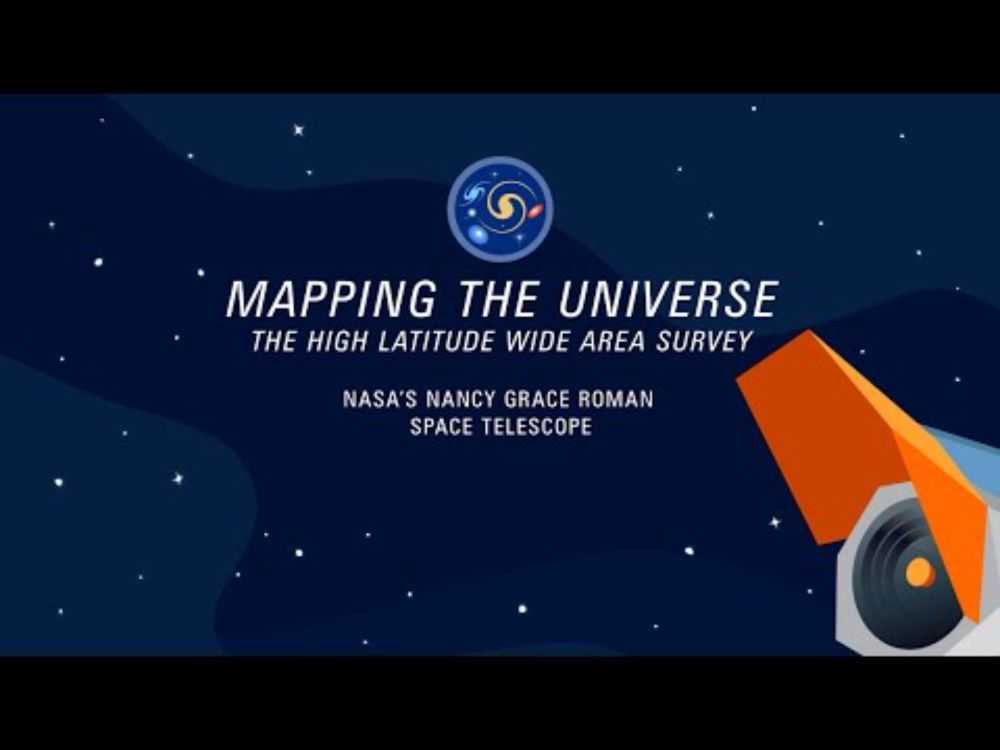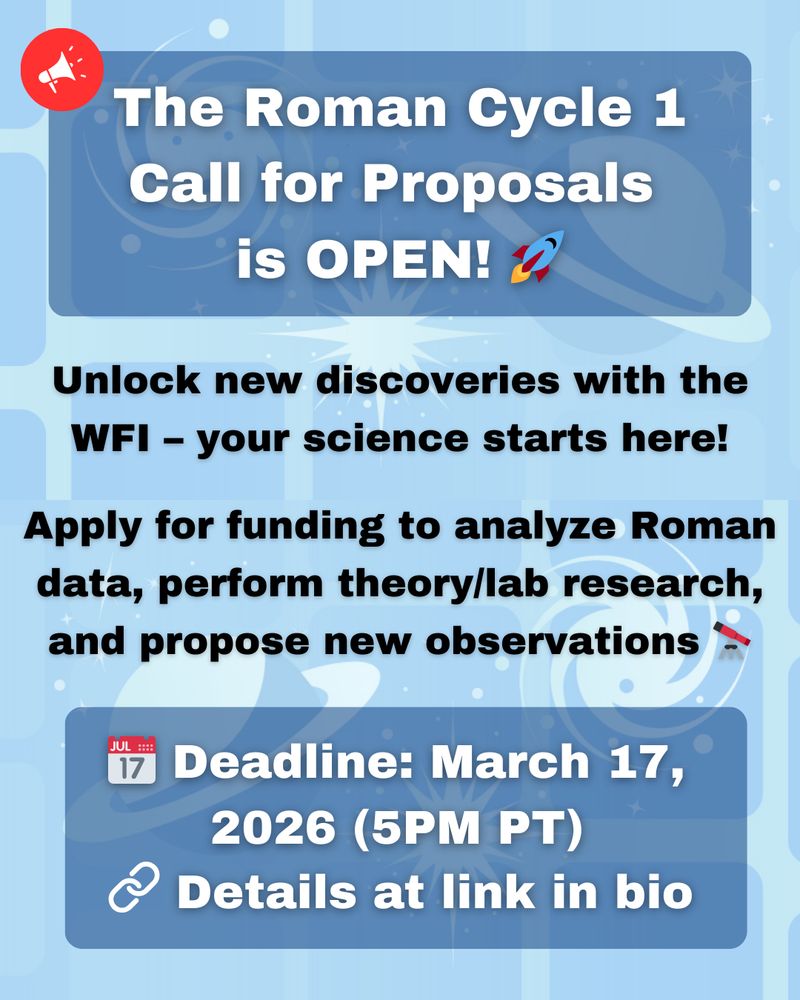
🚀The Roman Cycle 1 Call for Proposals is OPEN!
Unlock new discoveries with the Wide Field Instrument—your science starts here! Apply for funding to analyze Roman data, perform theory/lab research, and propose new observations. 🔭☄️
📅 Deadline: Mar 17, 2026 (5 PM PDT)
📝 bit.ly/4q3jbbL
10.12.2025 17:01 — 👍 18 🔁 15 💬 0 📌 4

THis poster advertises the Geo SonNet Town Hall on December 15th 2025, from 18:00-19:00 in Room 243-244 Convention Center. Who should attend? Data scientists curious about sonification, researchers seeking more intuitive sound mapping options for complex datasets, existing projects looking for new collaborative partners. There are two QR codes, one to join the listserve, another for the Geo SonNet.
Heading to the @agu.org annual meeting, interested in using sound to help interpret your complex data, AND make your research more inclusive? Data sonification can help! But don't take my word for it: www.youtube.com/watch?v=X_eU...
Attend the Geo SonNet Town Hall on Dec. 15th to network!
25.11.2025 20:41 — 👍 2 🔁 2 💬 0 📌 0
Very cool data sonification of Roman science! But I really wish these had a short audio narration in front to provide context. Helps anyone watching this better understand the sounds, and if you are BVI this is just a bunch of weird noises!
20.11.2025 15:04 — 👍 2 🔁 0 💬 1 📌 0

Promotional image for Inbox Astronomy featuring the James Webb Space Telescope against a starry background, highlighting the latest news, images, and discoveries about the universe.
What do you get if you sign up for Inbox Astronomy? Spectacular images and astronomical discoveries! Sign up to get news from the universe right in your inbox: https://bit.ly/3KSp8IY 🔭 🧪
18.11.2025 14:54 — 👍 19 🔁 5 💬 0 📌 1

A logo "HSLA" which stands for Hubble Spectroscopic Legacy Archive, has three stylized spectra with rainbow colors radiating from left to right. In the background are stars, galaxies, and a giant planet.
Hey #astrosci community! After working on this project for 3 years, there's a new Hubble Spectroscopic Legacy Archive that's just been newly made available at @stsci.edu: archive.stsci.edu/missions-and... follow me to learn more! (1/n)
17.11.2025 19:17 — 👍 34 🔁 8 💬 1 📌 3
We added some nice features to our JWST Search interface. HST rolling out in next couple months, along with more goodies.
02.10.2025 20:30 — 👍 11 🔁 2 💬 0 📌 0
Technicians recently tested two major deployments for the Nancy Grace Roman Space Telescope: the Deployable Aperture Cover (DAC) and the Solar Array Sun Shield (SASS): go.nasa.gov/41X95PN #NASARoman 🔭 🧪
27.08.2025 17:22 — 👍 88 🔁 15 💬 2 📌 1
When I decided to pursue astronomy as a career, inspired by Star Wars, there were no known real planets orbiting stars like the Sun. Now we can take baby photos and SEE them. Incredible, and building off of decades of work by others who came before to get us collectively to this place.
26.08.2025 15:09 — 👍 8 🔁 0 💬 0 📌 0
Four years' worth of Ca HK activity measurements with more planned on the way. Great dataset for anyone exploring stellar activity now at MAST!
20.08.2025 15:51 — 👍 7 🔁 0 💬 0 📌 0
@commondescentpod.bsky.social Motivation for a Silver Screen episode on Star Wars? Best Star Wars planets for optimal fossilization? What kind of dinosaur was Boba Fett riding in the Christmas Special? Were krayt dragons actually dragons? Dragon*con topic perhaps!? www.wired.com/story/an-anc...
19.08.2025 15:25 — 👍 2 🔁 0 💬 0 📌 1
The more we look with #NASAWebb, the more we find! The latest discovery? A tiny new moon orbiting Uranus. It’s just six miles (9.6 kilometers) in diameter: science.nasa.gov/blogs/webb/2... 🔭 🧪
19.08.2025 15:04 — 👍 91 🔁 37 💬 1 📌 9
Job for AWS experts – become Senior Cloud Software Developer at @stsci.edu, apply by Sept 19:
recruiting2.ultipro.com/SPA1004AURA/...
19.08.2025 14:35 — 👍 1 🔁 1 💬 0 📌 0

An individual pulls tape from a dispenser at a desk with stacks of white boxes and astronomical images in the background.

A tactile panel of Uranus shows the blue planet and rings on a black background.

A tactile panel of Uranus shows the blue planet and rings on a black background. The image was taken from a side to show the three dimensional component. The panel is sitting on a wooden table.
Tim Rhue, education specialist at STScI, packs up new tactile panels based on the first #NASAWebb image of Uranus. These panels are being sent to museums, libraries, and other educational sites, so that they can share this tactile experience with their audiences. 🔭
12.08.2025 20:37 — 👍 41 🔁 5 💬 0 📌 1
Yes this, unlike other more common industries with much larger applicant pools, astrophysics (and things like software engineers applying their craft to a specialized field like this) is not something than can be restocked quickly en masse, and many who left won’t just come back from their new jobs.
04.08.2025 20:01 — 👍 3 🔁 0 💬 0 📌 0
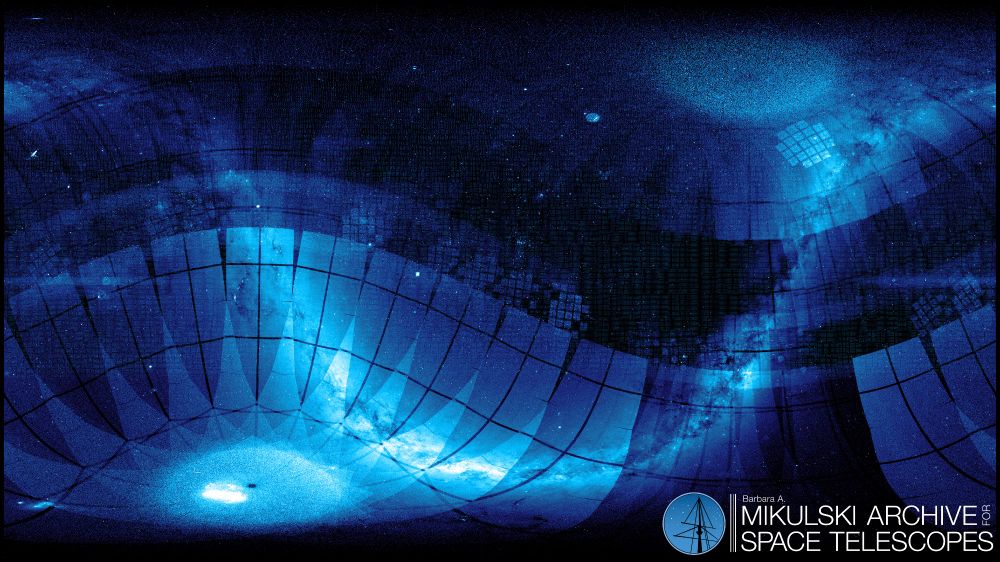
MAST background in "standard" sky projection, in hues of blue. Lighter blue areas mark lots of observations, while darker areas are less. Numerous patterns are visible, like the continuous viewing zones as ovals in the lower-left and upper right, patterns from overlapping TESS FFIs, or the Kepler footprint shapes stamped along the ecliptic and in the original Kepler field in the upper-right.
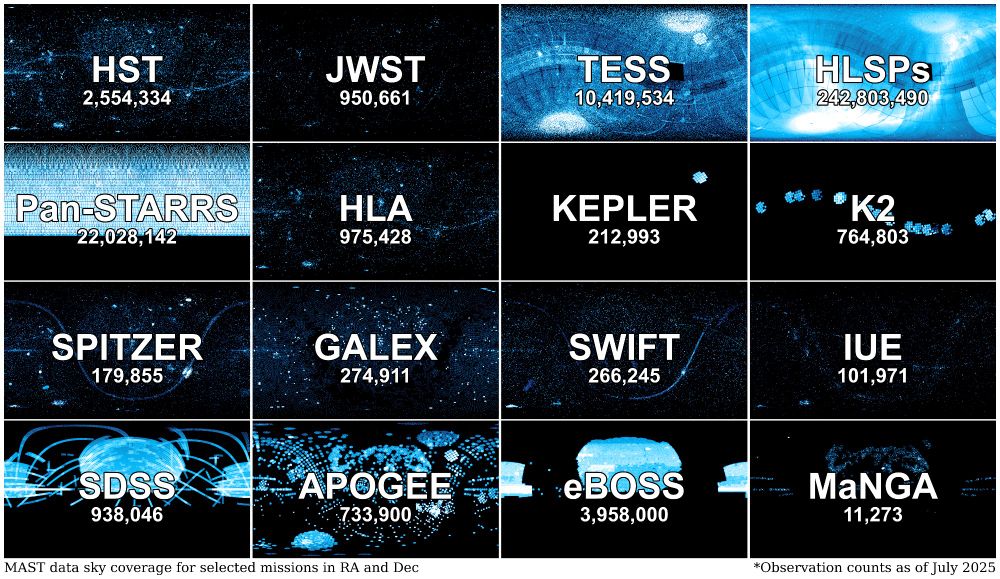
A grid of 16 images, 4x4, showing the sky background only for specific missions to get a sense of where in the sky and how much of it each mission observed to at least some depth.
Ever wondered what the "MAST Sky" looks like, from our ~6 PB of data spanning 3 decades...check this out! spacetelescope.github.io/mast-blog/ma...
Really fun project led by the very talented Julie Imig at MAST, showing mission coverage sky-projected! They make VERY good video backgrounds, btw. 🔭
31.07.2025 21:12 — 👍 40 🔁 9 💬 0 📌 2
NASA's new PUNCH mission is a constellation of 4 small satellites that collectively provide an unprecedented view of giant eruptions breaking free from the Sun.
This first-release video compresses about 6 days of observations. 🧪🔭
science.nasa.gov/blogs/punch/...
28.07.2025 20:44 — 👍 224 🔁 44 💬 11 📌 1
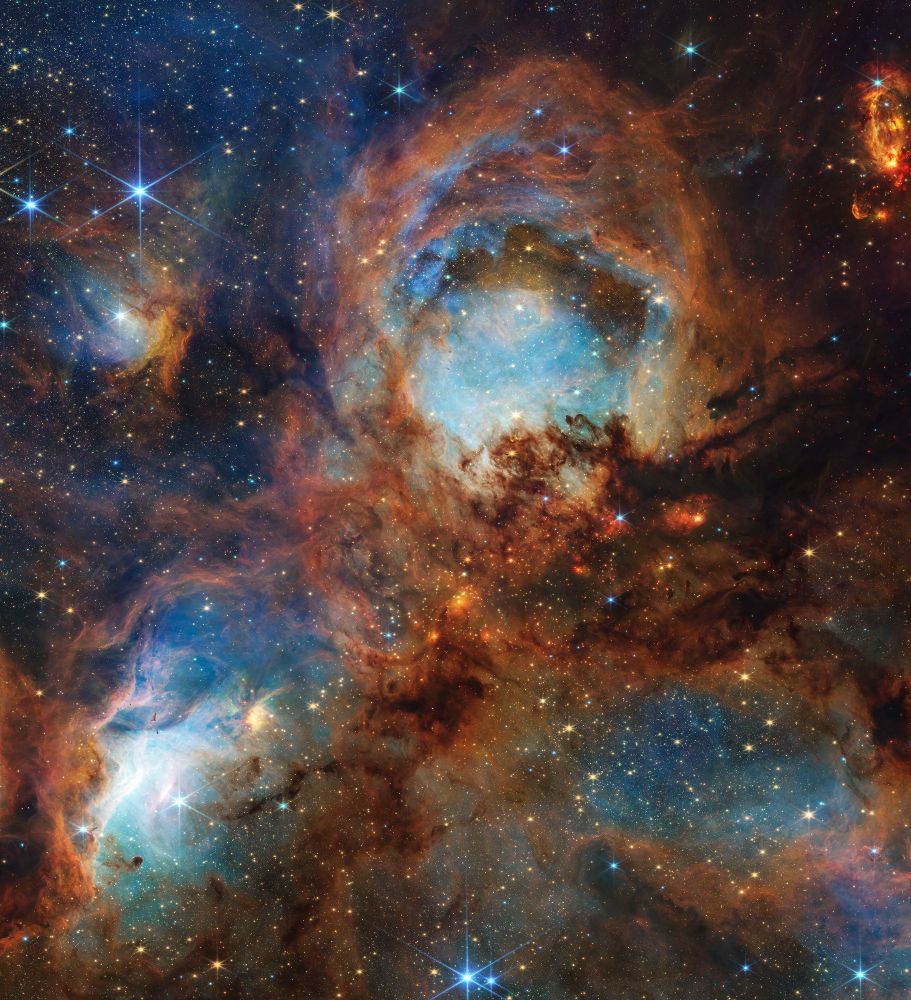
A section of the Cat’s Paw Nebula, a local star-forming region composed of gas, dust, and young stars. Four roughly circular areas are toward the center of the frame: a small oval toward the top left, a large circle in the top center, and two ovals at bottom left and right. Each circular area has a luminous blue glow, with the top center and bottom left areas the brightest. Brown-orange filaments of dust, which vary in density, surround these four bluish patches and stretch toward the frame’s edges. Small zones, such as to the left and right of the top-center blue circular area, appear darker and seemingly vacant of stars. Toward the center are small, fiery red clumps scattered among the brown dust. Many small, yellow-white stars are spread across the scene, some with eight-pointed diffraction spikes that are characteristic of Webb. A few larger blue-white stars with diffraction spikes are scattered throughout, mostly toward the top left and bottom right.
Hooray for three years of paw-sitively amazing #NASAWebb science! To celebrate, the telescope examined a singular “toe bean” of the Cat’s Paw Nebula, a massive star-forming region. Webb reveals gas, dust, and massive young stars: webbtelescope.pub/4khJK9T 🔭
Reply with an image of your pet’s paws! 🐾
10.07.2025 14:05 — 👍 288 🔁 60 💬 19 📌 11
This is what we are doing after Roman. But only if NASA science funding is kept at the levels we need. It takes decades to plan and build these missions, and it’s only possible through steady public support AND stable federal funding throughout the years.
08.07.2025 20:49 — 👍 3 🔁 1 💬 0 📌 0
The work our talented team does to ensure the public learns about discoveries made with NASA telescopes, and our place in the Universe, risks being lost without at least keeping NASA’s funding flat. The current budget plan removes almost all of it. If this matters to you, make sure your reps know.
02.07.2025 20:28 — 👍 6 🔁 3 💬 0 📌 0
Links to register to all our events!
www.blackinastro.com/black-space-...
14.06.2025 17:37 — 👍 8 🔁 10 💬 1 📌 0
I present the #astrocode Pyriod for interactive or scripted pre-whitening frequency analysis of astronomical time series data. See the demo of #stellarastro #TESS data analysis of a pulsating white dwarf star. Check it out at github.com/keatonb/Pyriod/.
09.06.2025 20:26 — 👍 13 🔁 2 💬 0 📌 0
Excited for #BlackSpaceWeek 2025! #BlackInAstro
23.05.2025 16:30 — 👍 8 🔁 3 💬 0 📌 0
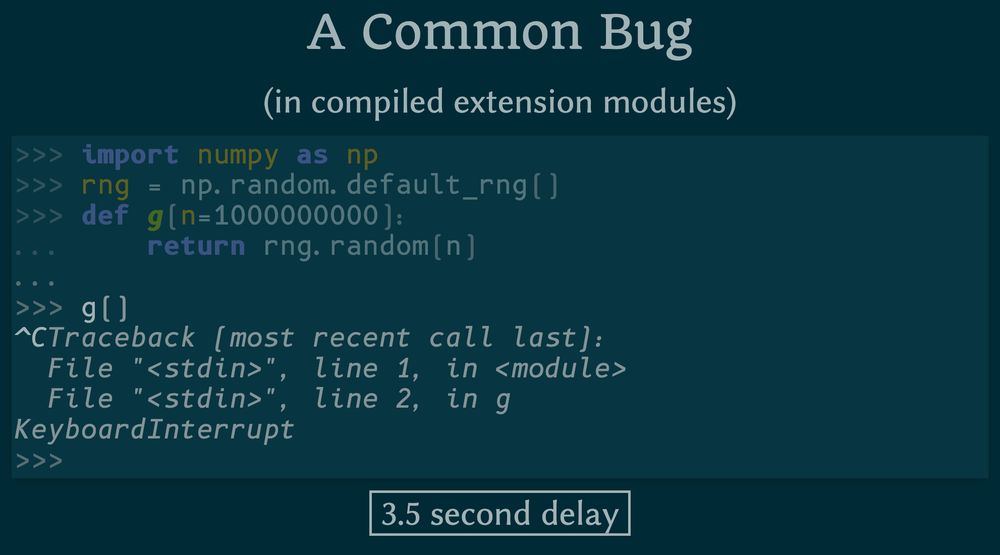
A code block labeled "A Common Bug (in compiled extension modules)." The code shows an attempt to exit a calculation of a large array of random numbers, and then indicates that a Ctrl+C interrupt takes 3.5 seconds to return, rather than returning immediately as is probably the desired and expected behavior.
Have you ever started a Python process, realized that you made a mistake, immediately hit Ctrl+C to interrupt it and then waited a surprisingly long time to get the command line back?
This delay is caused by a bug in the compiled #Python extension.
:thread:
20.05.2025 15:46 — 👍 15 🔁 7 💬 2 📌 1
Professional astronomers: Follow this official account that will keep researchers up to date on preparing for and participating in Roman research!
16.05.2025 13:54 — 👍 1 🔁 1 💬 0 📌 0
Learn how to use our powerful cloud platforms at the AAS meeting in Alaska! We need more interested attendees! 🔭
15.05.2025 20:41 — 👍 2 🔁 0 💬 0 📌 0
NEW: Those undulations aren’t clouds—they’re Jupiter’s aurora as seen by #NASAWebb. Webb observed light from a particular molecule, represented in orange, and found that the planet’s aurora fluctuates on timescales of minutes or seconds: webbtelescope.pub/4kbsB20 🔭 🧪
12.05.2025 12:02 — 👍 672 🔁 120 💬 10 📌 8
Experience the Cosmic Cliffs like never before! #NASAWebb’s iconic image of dusty “mountains” and “valleys” is featured in a new 3D visualization from NASA’s Universe of Learning: webbtelescope.pub/4jRHIh9 🔭 🧪
07.05.2025 18:02 — 👍 566 🔁 109 💬 11 📌 7
We are working on resolving this.
02.05.2025 17:37 — 👍 1 🔁 0 💬 1 📌 0
For those attending the AAS in the summer, consider signing up to take our data workshop where you'll learn how to effectively use our cloud platforms to query for data, access catalogs, and create image cutouts! Very relevant for TESS and Roman astronomers in particular, but all are welcome!
30.04.2025 18:03 — 👍 2 🔁 1 💬 0 📌 0
YouTube video by Space Telescope Science Institute
Nancy Grace Roman Space Telescope: Mapping the Universe
Astronomers will use #NASARoman to improve our understanding of the universe. See the bigger picture with Roman. Credit: NASA, STScI, Caltech/IPAC. 🔭 🧪
29.04.2025 17:04 — 👍 55 🔁 15 💬 1 📌 1
We are here to affirm that you DO belong in STEM! This is a safe space for people with disabilities in STEM to connect. Contact: disabledinstem@gmail.com
Husband and father. Proudly serving as Illinois’ 43rd governor.
Astronomy & Astrophysics Ph.D. Student at the University of Arizona | High-Contrast Imaging of Exoplanets and Brown Dwarfs 🪐
Astronomer at University of Arizona's Steward Observatory. Instrument builder: LFAST, NEID, HPF. Building giant telescopes! Hobbyist woodworker. Decent vinyl collection.
Assistant Professor of Physics & Astronomy at UW–Madison | Investigating exoplanets, stellar evolution, & planetary engulfment | 🛰️
Galactic Janitorial Services
Dad. Author of the Cosmic Collisions books. Astrophysicist and Citizen Science fanatic @nasa. www.marckuchner.com
President of Signal, Chief Advisor to AI Now Institute
Dad Lander. Former Councilmember Lander. Comptroller Lander (until 12/31). Running for Congress because we need to fight, not fold. 🥊
landerfornyc.com
https://secure.actblue.com/donate/lander-socials
Mayor-Elect of New York City
A podcast where Payel Das (@payeldas.bsky.social) and Michelle Collins (@runningastronomer.bsky.social) discuss papers from astroph
Starxiv.com
Spotify - https://shorturl.at/xdTFw
Apple - https://shorturl.at/nKFNj
RSS - https://rss.com/podcasts/starxiv
A nerd at large. Writer. Musician.
Sometimes funny. 🏳️🌈
Join my sci-fi book club:
http://patreon.com/ellecordova
nerd humor • space & sci fi • books
CEO of Million Concepts. We empower teams to make better data-driven decisions under pressure. The mission won't wait for you.
Astronomer and planetary scientist. Software engineer. Project manager. Magician. Writer at sol-orietur.ghost.io
planetary scientist 🪐 science illustrator 🎨 trekkie 🖖 dog dad 🐶 Pasadena 🌹 views are my own 🏳️🌈 he/him
Waitress turned Congresswoman for the Bronx and Queens. Grassroots elected, small-dollar supported. A better world is possible.
ocasiocortez.com
A podcast about paleontology, evolution, and the history of life on Earth.
Hosted by Will🐊 and David🐍
https://commondescentpodcast.com/
Galaxy cluster astronomer. Associate professor of physics. Chair of Science, Technology, & Society Dept.
she/hers; all things galaxy formation, dark matter & pug related.
⚛️ Highschool physics teacher ➡️ Astro🔭 MA @ Wesleyan ➡️ TESS science support staff @ MIT
















